
Apidae is the largest family within the superfamily Apoidea, containing at least 5700 species of bees. The family includes some of the most commonly seen bees, including bumblebees and honey bees, but also includes stingless bees, carpenter bees, orchid bees, cuckoo bees, and a number of other less widely known groups. Many are valuable pollinators in natural habitats and for agricultural crops.
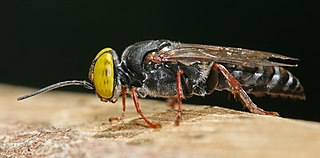
The Crabronidae are a large paraphyletic group of wasps, including nearly all of the species formerly comprising the now-defunct superfamily Sphecoidea. It collectively includes well over 200 genera, containing well over 9000 species. Crabronids were originally a part of Sphecidae, but the latter name is now restricted to a separate family based on what was once the subfamily Sphecinae. Several of the subfamilies of Crabronidae are often treated as families in their own right, as is true of the most recent phylogenies.
Michael S. Engel, FLS, FRES is an American paleontologist and entomologist, notable for contributions to insect evolutionary biology and classification. In connection with his studies he has undertaken field expeditions in Central Asia, Asia Minor, the Levant, Arabia, eastern Africa, the high Arctic, and South and North America, and has published more than 983 papers in scientific journals and over 925 new living and fossil species. Some of Engel's research images were included in exhibitions on the aesthetic value of scientific imagery.

Commonly known as cuckoo wasps or emerald wasps, the hymenopteran family Chrysididae is a very large cosmopolitan group of parasitoid or kleptoparasitic wasps, often highly sculptured, with brilliant metallic colors created by structural coloration. They are most diverse in desert regions of the world, as they are typically associated with solitary bee and wasp species, which are also most diverse in such areas. Their brood parasitic lifestyle has led to the evolution of fascinating adaptations, including chemical mimicry of host odors by some species.

The Tetracampidae are a small family of parasitic wasps in the superfamily Chalcidoidea. They are parasitoids of phytophagous insects, primarily flies. The 44 species in 15 genera are almost entirely absent from the New World.

A wasp is any insect of the narrow-waisted suborder Apocrita of the order Hymenoptera which is neither a bee nor an ant; this excludes the broad-waisted sawflies (Symphyta), which look somewhat like wasps, but are in a separate suborder. The wasps do not constitute a clade, a complete natural group with a single ancestor, as bees and ants are deeply nested within the wasps, having evolved from wasp ancestors. Wasps that are members of the clade Aculeata can sting their prey.
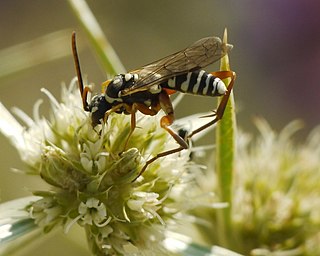
The Ceropalinae are a subfamily of the Pompilidae, the spider wasps, containing two genera, whose members are kleptoparasitic on other solitary wasps which hunt spiders, mainly fellow members of the Pompilidae.

Sphecodopsis is a genus of cleptoparasitic cuckoo bees in the family Apidae. Endemic to southern Africa, the wasp-like bees of this genus are generally small, varying from 3.9 to 9 mm in length, and mostly black, with orange-ish or reddish colouring of the metasoma in some of the species. The bee genus Scrapter is recognised as a host for the cleptoparasitic life cycle of some Sphecodopsis, but further data regarding preferred hosts is not available for most of the species.
The genus Foxia is a group of cleptoparasitic bembicine wasps that occur in xeric habitats in the New World. There are 10 described species, ranging from Chile and Argentina to the United States.
Ireangelus is a genus of kleptoparasitic spider wasps from the sub-family Ceropalinae of the family Pompilidae. The genus has a pan tropical distribution, being known from Oriental, Neotropical, Australian, eastern Palearctic, and Madagascan Zoogeographic regions being best represented in the Neotropics. Irenangelus is closely related to the more widespread genus Ceropales, the two genera forming a monophyletic subfamily, Ceropalinae within the Pompilidae. This is regarded as the most basal grouping of the Pompilidae but this view is problematic because of the kleptoparasitic life history of the Ceropalines, it is now considered that they Ceropalines and other pompilids evolved from a common ectoparasitoid ancestor.

Nysson spinosus, the large-spurred digger wasp, is a species of cleptoparasitic wasp of the family Crabronidae which is found in the Palearctic.
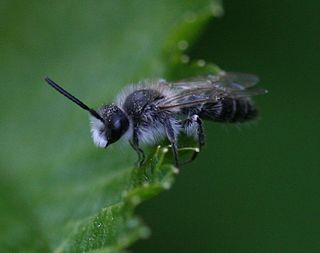
The bearded miner bee is a species of miner bee in the family Andrenidae. It is found in Europe and Northern Asia and North America. Other common names include the long-lipped andrena and the sandpit mining bee.

Epeolus mesillae is a species of cuckoo bee in the family Apidae.
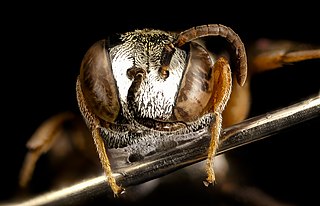
Epeolus howardi, or Howard's cellophane-cuckoo bee, is a species of cuckoo bee in the family Apidae. It is found in North America.
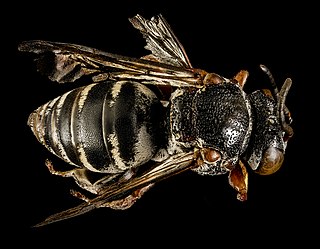
Epeolus lectoides, the cuckoo bee, is a species of cuckoo bee in the family Apidae. It is found in North America. Hosts include Colletes latitarsis and Colletes nudus.
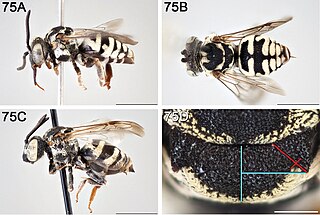
Epeolus olympiellus is a species of cuckoo bee in the family Apidae. It is found in North America.

Townsendiella pulchra is a species of cuckoo bee in the family Apidae. It is found in Central America and North America.
Triepeolus grindeliae is a species of cuckoo bee in the family Apidae. It is found in North America.
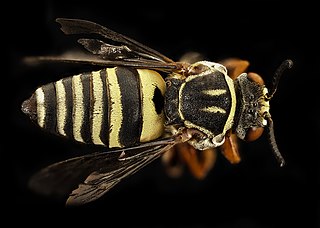
Triepeolus distinctus is a species of cuckoo bee in the family Apidae. It is found in North America.
Van der Vecht's gland or Van der Vecht's organ is a gland which is located in an area of modified cuticle on the rearmost gastral sternite of female wasps. This gland secretes chemicals which are important in the determination and maintenance of the hierarchy of groups of eusocial wasps and are used in the defence of the nests in others. In the Asian giant hornet the van der Vecht's gland is used to scent mark hives of honey bees to attract other members of their colony to cooperatively attack the hive; the only known case of the gland's use to scent mark a food source. In the cleptoparasitic paper wasp Polistes semenowi the female usurps the host foundress, usually Polistes dominula and uses an enlarged Van der Vecht's gland to produce large quantities of hydrocarbons and to control the host workers, and even sometimes the host foundress. The gland was discovered by, and named in honour of, the Dutch entomologist Jacobus van der Vecht.















